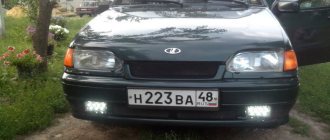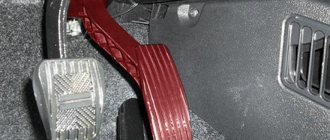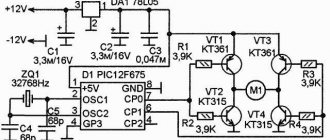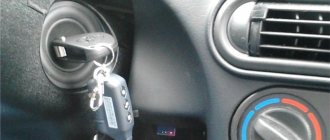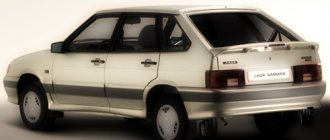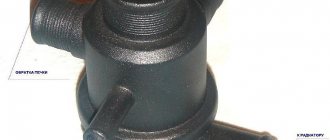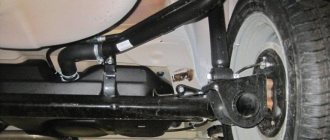Design
The damper is a rotary disc valve on a horizontal axis, which is opened by tensioning the cable from the control (gas) pedal.
It returns to the closed position under the action of a spiral spring. The drive cable is attached to a sector lever mounted on the rotary valve axis. The aluminum alloy housing contains an air diffuser that houses the damper mechanism. In addition, channels for coolant are cast in the body, for the passage of air at idle, crankcase ventilation, purging the adsorber and supplying vacuum to the vacuum brake booster. The idle speed control and throttle position sensor are installed on the housing and are electrically connected to the engine ECU. The throttle body is attached to the intake manifold on two threaded rods through a gasket.
To connect hoses, all channels of the housing have fittings (nozzles).
Operating principle and device
The device is an air valve, the position of which changes when the gas pedal is moved. The throttle assembly includes several parts:
- Frame.
- Remote control position sensor, which reads information about its position and transmits it to the engine ECU.
- The idle channel through which air enters the manifold when the gas pedal is released.
- Canister purge hose fitting.
- Idle speed regulator, which changes the air flow when the throttle body is closed.
- A throttle valve that directly regulates air flow and pressure in the manifold.
- Crankcase ventilation hose fitting.
- Remote control drive, including an axis, spring and other elements.
- Heating unit fittings (heating is carried out by coolant).
The throttle body is attached to the intake manifold. A gasket is used to seal the joint.
The node works as follows:
- When you move the gas pedal, the damper rotates on its axis and opens air access.
- The pressure in the manifold increases, causing more fuel-air mixture to enter the cylinders.
- Engine power and fuel consumption increase.
A closed air valve creates a vacuum in the intake manifold. It is used to drive the brake booster and purge the adsorber that filters gasoline vapors.
Features of operation
The manufacturer equips the Chevrolet Niva engine with a throttle body with a 46 mm diffuser.
The control program and all sensors that monitor the parameters of a running engine work correctly only with the “native” unit.
Some car users, hoping to increase engine power by adding air, install a unit with a diffuser of increased diameter - 52, 54 and even 58 mm. Of course, the aerodynamic resistance of the air path as a whole is reduced, but the consumed amount of air remains unchanged and is almost equal to the volume passing through the stock diffuser.
The throttle valve is not a turbocharger; supplying air to the cylinders at high pressure is not its function.
An increase in the transverse size of the damper diffuser reduces the aerodynamic resistance of the air path as a whole, but the resulting increase in power and changes in other engine parameters can only be determined in laboratory conditions, using instruments. The only thing that the car user will feel is that the engine (without load!) began to respond more quickly to pressing the gas pedal.
When replacing the damper with a larger one, you must definitely change the parameters in the car’s firmware (reflash).
A completely different situation arises if the engine has undergone tuning, with an increase in cylinder diameter, piston stroke and a change in valve timing (block boring, different crankshaft and camshaft). In this case, specialists who have made a “sports” engine out of a standard engine must know in advance - or calculate - the required cross-section of the throttle unit diffuser (changes also need to be made to the program of the ECU unit).
This is interesting: Design of the master brake cylinder of a passenger car and replacement of the repair kit
Even after repairs with replacement of the piston, it is recommended to install a unit with a flow area of no more than 52 mm on a typical engine.
During operation, any engine wears out. Through the increased gaps between the piston rings and the cylinder walls, gases from the combustion chamber begin to penetrate into the crankcase and, together with the oil mist in the crankcase, enter the idle channel through the crankcase ventilation system. The possibilities of the air filter are not limitless; dust particles less than 0.5 microns in size pass through any “sieve”. The smallest particles of carbon deposits, dust and oil, meeting in the throttle body, turn into low-temperature sludge and settle on surrounding surfaces.
As a result: the resistance of a dirty diffuser increases, the damper overgrown with “moss” prevents air movement. The crankcase ventilation pipe, idle air control valve and its channel are clogged with dirt.
The design of the throttle valve mechanism is simple, virtually wear-resistant and very durable. Only internal contamination can disrupt its normal operation.
External tuning – functionality and aesthetics
Nowadays, it is customary to criticize and scold any product of the Volzhsky Automobile Plant: demanding modern users either lack comfort or the engine is not powerful. Even a truly successful model for the Volzhsky Automobile Plant does not remain without criticism from disgruntled owners.
But, however, any shortcomings of the car can be easily compensated for by tuning the Chevy Niva with your own hands. Any car can be customized according to the owner's vision if you put in a little time and effort. How much better, more powerful, more modern the car will become depends only on the diligence and originality of the performers.
Most often, transmission tuning involves some measures to reduce vibrations that occur in the front gearbox and are transmitted to the entire car body. Attempts to install self-locking gearboxes are also no less common. But if measures to reduce vibration are clearly necessary for the car and passengers, then all kinds of differentials with a high coefficient of friction and ball “self-blocks” will significantly complicate the use of the car.
Difficulties when using this kind of units, as a rule, rest on the not very high resistance of structural materials. Barely surmountable design flaws of modern devices prevent their effective use. Many Chevrolet Niv owners note the negative results of such DIY modifications. In some cases, repairs are required altogether.
It’s not for nothing that reviews from fans of this kind of modifications recommend putting the factory rear axle gearbox in the trunk and always carrying it with you, i.e. one day it will definitely be needed. But Chevy Niva tuning is very often narrowly focused and is carried out with the goal of improving the road properties of the car. The installation of wheel gears is quite reasonable here.
An ordinary standard engine, after chip tuning, demonstrates performance indicators that significantly exceed the norm. The engine, whose design has undergone major changes and in which the volume of the combustion chamber has been increased, the weight of the crankshaft and connecting rods has been reduced, and a tuning camshaft and split gear for the gas distribution mechanism have been installed, simply needs to refine the control program.
Among those who like to carry out chip tuning with their own hands, there is a belief that the electronic engine control blog of the all-wheel drive Chevy Niva does not tolerate interference, and progressive self-learning technology makes any kind of effort to refine the firmware useless. Such features are actually characteristic of electronic engine control units Bosch 7.9.0, M7.9.7 and M7.9.7.
But the January 7.2 ECU equipment installed on tuned cars is completely devoid of this kind of shortcomings. The calibration of its read-only memory can be changed during a firmware update. As a result, the increase in power obtained after chip tuning the Chevy Niva engine reaches 15% in some cases.
Any vehicle that is used in or near off-road conditions requires the installation of several functional elements and external accessories. Perhaps the most important thing is to install a bumper with a winch - if you get stuck, the winch will be very useful. The functionality of this element is undeniable.
Durable steel, three millimeters thick, which is integral with the engine protection, will ensure the safety of the body in extreme road conditions. Additional headlights recessed into the bumper are usually equipped with fog filters. Inside such a bumper, there will also be a perfect place for a winch and towing loops.
When choosing a winch model, you should prefer devices with polymer ropes. Steel cables are extremely inconvenient - they get pinched among the turns, although they are stronger.
Some Chevy Niva owners strive to give the car an aggressive look by decorating it with metal arches. But it is worth remembering that such arches, attached to the front, back or side, always do more harm than good. As a result, clearance is significantly reduced. But nevertheless, many car enthusiasts sacrifice functionality for the sake of aesthetics.
But one cannot fail to recognize a roof rack mounted on the roof as a very useful acquisition. Its carrying capacity is quite small, but if necessary, it can easily accommodate several cans of fuel.
Tuning the interior of the Chevy Niva does not have priority, because... For a domestically produced SUV, the interior is quite decent and even respectable. The only thing that can be done is to replace the standard seats with more comfortable and safe ones. But again, you shouldn’t experiment with installing exotic seats if the main focus of tuning is on subsequent off-road driving.
If the goal is to create a respectable car that can perform well in off-road conditions, then the interior can be completely redone and reupholstered, as well as tuning the Chevy Niva dashboard. But there is unlikely to be a desire to modify the external data of this car in the released restyled version.
We touched upon only a few individual aspects of tuning a Chevy Niva. The widest opportunities for independent tuning will be given to you by the availability of parts, the availability of design projects and, of course, the willingness to spend more than one day in the garage.
What does the bore diameter affect?
The amount of air-fuel mixture that enters the cylinders determines the power of the engine. It depends on two factors:
- Valve opening degree - from 0 to 100%.
- Cross-section of the passage hole.
The first indicator depends on the position of the gas pedal, and the second on the design of the throttle assembly.
The factory equipment of the Chevrolet Niva provides for the installation of a damper with a diameter of 46 mm.
To increase the air supply and engine power, car owners install diaphragms with a large diameter - from 52 to 58 mm.
Important: engine power does not increase in proportion to the valve diameter. The amount of fuel-air mixture depends on the working volume of the cylinders. The standard size of the passage opening is sufficient to fill the combustion chamber. Increasing the valve diameter cannot radically change the characteristics of the motor.
The maximum size of the tuning damper that should be installed on a standard Chevrolet Niva engine is 54 mm. A larger diameter (56 mm) is needed only for sports versions of cars with an increased engine capacity.
Increasing the throttle flow area without modifying the engine only gives the illusion of an increase in power. The response to pressing the gas pedal becomes sharper.
For example, if you lightly press the gas, the standard throttle will open 10%, and the extended throttle will open 15-20%. At the same time, the maximum power and throttle response remain virtually unchanged. In order for the combustion chambers to be completely filled with the fuel-air mixture, you do not have to press the pedal all the way.
It happens that after installing an increased emergency protection, the standard engine actually becomes more powerful. This has a simple explanation: instead of the old clogged damper, a new clean one is installed. The same effect can be achieved by a simple and cheap method: remove and wash the throttle assembly.
Advice: it makes sense to install an enlarged throttle after boring the cylinders and installing a sports camshaft, which changes the valve timing.
Upgrading the suspension to match the new transmission
After tuning the transmission due to inertia, it is necessary to modify the suspension. Experienced Niva owners, even without changing the basic characteristics of the car, often replace standard suspension parts with more reliable ones that are resistant to operational loads. The practice of replacing rubber bushings with polyurethane ones is quite common and should be taken into account by each Chevy Niva owner.
Polyurethane silent blocks, couplings, seals, limiters and similar suspension elements last several times longer than conventional rubber ones. They are also not sensitive to temperatures and petroleum products, and work well in rupture and compression.
Installing double shock absorbers, contrary to the assurances of skeptics, will not make the suspension inert. Double shock absorbers will increase the car’s ability to withstand dynamic vehicle loads and make it possible to drive the car off-road at high speed.
Symptoms of a malfunction and how to fix them
The throttle valve mechanism has a high safety margin and is almost not subject to wear. Problems arise due to contamination of the unit. Atmospheric air, which passes through the throttle in large volumes, is cleaned by an air filter.
This is interesting: In what cases is the low beam lamp replaced and how to change it yourself
However, tiny particles of dust remain in it, which settle on the parts of the mechanism. The process is aggravated by small splashes of oil that penetrate along with crankcase gases.
A coating forms on the walls and damper, which prevents the damper from closing completely or interferes with its smooth operation. Clogged channels of the unit create air resistance, as a result of which engine power decreases.
Signs of remote control contamination:
- Unstable engine operation at low speeds.
- Jerking when driving at low gas.
- Problems starting the engine.
- Power drop.
To eliminate the problem, you need to clean the throttle valve. This can be done with a special aerosol that dissolves plaque on the inner surface of the throttle assembly.
How to check TPS
The most convenient way to check the operation of the Niva Chevrolet TPS is by testing . For this you will need a multimeter. The goal is to determine the presence of power at the sensor contacts, measure the voltage and identify the causes of the breakdown. They may be a malfunction of the unit itself, poor contact between the slider and the resistor track, or problems in the vehicle's electrical network.
Availability of "ground"
The purpose of the test is to measure the “negative” power supply, the sensor:
- Disconnect the power cord from the connector.
- Inspect for the presence of dirt , oxidation or mechanical damage.
- Set the multimeter to 20V DC voltage (DCV).
- Turn the ignition key to the ON position (do not start the engine).
- Connect the red probe of the multimeter to the “plus” on the battery.
- Touch each of the three contacts on the wiring connected to the sensor with black.
On one of the contacts the device screen will show a voltage of 12V . This means that there is a ground on the sensor. If power is not displayed on any of them, the reason for the malfunction of the Niva Chevrolet throttle sensor is the absence of a “ground”.
Powered by reference voltage
The purpose of the test is to measure the power supplied to the TPS. The operation of the mechanism will be disrupted if there is insufficient or missing voltage :
- Connect the black probe of the multimeter to ground.
- Turn the ignition key to the ON position. Do not start the engine.
- Connect the red probe to each of the remaining two contacts of the sensor.
- One of them will display a power supply of about five V. The third wire will be the signal wire.
If voltage is not detected on any of the wires , the cause of the Niva Chevrolet TPS malfunction is in the electrical wiring.
Checking the output signal
The purpose of the measurement is to check the value produced by the sensor when the throttle is operating. Reconciliation is done in different positions - fully open, closed and fully closed throttle:
- Connect the red probe of the multimeter to the signal terminal, and the black one to the ground contact.
- Turn the ignition to ON position . Do not start the engine.
- Make sure the throttle valve is completely closed.
- The multimeter should show a value of 0.7 V.
- If the screen shows 0, continue : gradually open the throttle slightly. The value should also increase. When open all the way, the voltage is in the range of 4-5 V.
- If the TPS does not produce five volts when the damper is open , replace it with a new one.
Important! When performing a check, an error may enter the memory of the on-board computer, which will be displayed by the “Check Engine” warning lamp. After completing repair work, clean the OBD system manually.
Throttle Position Sensor Repair
You can restore functionality by removing the sensor from the machine , inserting a flat-head screwdriver into the hole and making light rotational movements. This will clear deposits from the resistor track. If it doesn’t help, install a new one.
This is interesting: Replacing lamps on a Volkswagen Jetta 6: photos, instructions on how to change the front lamps on a Jetta
In all other respects, the Niva Chevrolet throttle sensor is not repairable . Therefore, if a malfunction is detected, it is recommended to replace it with a new one. It is preferable to install a contactless type. Although its price is much higher, the unit is more practical, unpretentious and durable.
Healthy . TPS is not subject to adjustment. The controller uses the minimum signal voltage at idle at an approved reference point.
Removing the throttle assembly in Niva
We remove the throttle assembly to replace the idle air control or throttle assembly gasket. Disconnect the negative wire from the battery. Partially drain the coolant.
Cleaning
Using a special aerosol to clean the remote control without dismantling it is possible only when it is lightly soiled. Therefore, if problems arise, it is better to dismantle the throttle and remove dirt using a carburetor cleaner.
For this you will need:
- Phillips and flathead screwdrivers.
- 13mm head with extension.
- A can of cleaning product (“Carb & Choke Cleaner” or equivalent).
Attention: cleaning of the diaphragm must be performed after the engine has cooled down. Otherwise, there is a risk of getting burned by the coolant or hot parts of the engine and throttle.
To clean the throttle valve, you must perform the following steps:
- Remove the ground wire from the battery.
- Remove the plastic engine screen.
- Loosen the air duct clamp.
- Remove the air supply hose from the fitting on the throttle body.
- Loosen the clamps and remove the crankcase ventilation, coolant and adsorber pipes from the throttle pipes.
Attention: place a small container under the cooling system hoses to collect antifreeze.
- Bend the cooling system pipes upward and tie them to the hood pillar.
- Disconnect the wiring harness from the throttle position sensor (TPS).
- Disconnect the terminal from the idle speed control.
- Remove the spring clip from the drive pulley and unhook the cable.
- Unscrew the two nuts securing the throttle assembly.
- Remove the throttle.
- Unscrew the fastening screws and remove the idle speed control and TPS.
- Treat the insides of the throttle body with a cleaning agent.
Due to the fact that the liquid from the can is supplied under pressure, it effectively washes away plaque.
Reassembling the mechanism after cleaning is performed in the reverse order. Before installing the clamps, they should be lubricated with machine oil. This makes tightening easier and increases the reliability of the connection.
Adjustment
After the replacement is made, adjustments need to be made. The first thing to do is to loosen the fixing screw, then adjust the degree of tension of the screws until the gas pedal stops biting. After this, unscrew the nuts that secure the sensor and turn it a little to the desired position. If the desired result is achieved on a Niva Chevrolet, all the nuts must be tightened properly for reliability.
Device location.
Each vehicle is equipped with only the appropriate equipment, designed for a certain number of shaft rotations and installed in the appropriate seat. The Chevrolet Niva speed sensor is installed on the gearbox.
The sensor itself is a small steel or, more often than not, plastic device that is mounted in the shaft area. Inside the case there is a core that transmits impulses to a special controller responsible for displaying information on the instrument panel.
When carrying out work, it should be taken into account that the device can be quite fragile, so installation should be carried out with care.
